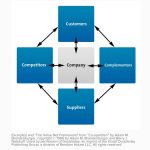Sailing to Startup Success Keep Your New Venture Balanced
Sailing to Startup Success:  keep your new venture on an even keel. I used to be a dinghy sailor and I can tell you that sailing requires many of the skills that an entrepreneur needs.
keep your new venture on an even keel. I used to be a dinghy sailor and I can tell you that sailing requires many of the skills that an entrepreneur needs.
First of all your boat/venture needs to be streamlined and carry exactly the right amount of weight. The boat/venture cannot carry excess baggage. Those on board must all contribute to stability and forward progress as they adjust their position to keep the boat/venture in balance. You need to know the difference between starboard and port and avoid early capsize.
In other words, you need to know the difference between sales and cash. If you run out of cash early on you will go bust. The Number Two reason why startups fail is that they run of cash. My 1982 startup narrowly avoided bankruptcy for that reason in month three.
Control Direction and Speed for Sailing to Startup Success
Two critical skills of the sailor/entrepreneur are about controlling direction and speed. Strategy and objectives need to be clear before leaving shore. After starting out the boat/enterprise has been set on a course, but to maintain it, many adjustments have to be made.
The sailor at the helm has to constantly trim the jib and mainsail, keep her hand on the tiller and shift her position to balance the wind’s force on the sail, hence the stability of the boat. I know to my cost that not paying attention to those indicators—capsize was imminent!
In the same way, the entrepreneur must monitor costs and revenue, even though her temptation is always to improve the product and make the sales. She has to scrutinize actual numbers and analyze increases and decreases to keep a handle on trends. She will need to take decisive and early action to avoid business capsize. If cash dries up she’ll sink; if sales don’t cover costs with a good surplus, she’ll soon be under water.
Upwind or Downwind Sailing Are Different; Stiff Competition or Fast Growth Also
Sailing upwind means that you can’t go in a straight line. You need to tack—or zig-zag in layman’s terms. The successful entrepreneur knows stiff competition means that you have to try alternatives and constantly watch what others in your market are doing.
Four critical rules will keep your new venture balanced and maintain it’s course…
- Define The Brand: just like a sailor facing a headwind, the entrepreneur needs goal clarity, while she takes twists and turns to get there. Brand definition is vital. When you watch other sailors/entrepreneurs taking different courses, do not be alarmed. If you’ve chosen your route wisely, you’ll win the race.
- Stay Close to Customers: a talented helmsman will not lose contact with crew members, nor with the sailing race spectators: the customers. With a very young business we stayed really close to our clients and built camaraderie among them by organizing events where they were front and center.
- Recognize Your Advantages: if the charts have been well analyzed and the sailor knows what she’s good at, she’ll maintain the advantage. The entrepreneur will have many doubts, but the confidence of knowing herself will give her strength.
- Avoid Overreaching: I have seen cocky sailors navigating too close to the wind in a race and then luffing (where you come to a standstill with flapping sails), others sailing downwind with too much sail out and doing an uncontrolled gybe (the boom crashing to the other side of the boat) with disastrous results. Likewise, uncontrolled revenue growth can sink the enterprise when it runs of cash because costs soar and receivables are delayed.
Single-minded Single-handed Sailing
I learned to sail dinghies as a schoolboy and then never sailed again till I turned forty. It was as though I’d never sailed before, but gradually, I relearned. I kept on with the dinghy after my first startup at 43. Now, at nearly double that age, I begin to see many parallels between the two experiences.
When it’s just you, the boat, wind and water, you have to be present all the time. Your mind cannot wander, or you get very wet. I found that I was constantly near my edge, just as I was in the new venture. Awareness, excitement, delight and fear were omnipresent. The constant interplay between keeping the boat balanced, the tiller just right, and the sail with the correct amount of wind leaves no room for distractions. The concentration is intense and unrelenting.
So it was with starting a new venture. Your mind is continually on the job. You may be having fun at a party, but there’s venture stream that never stops flowing. I think the very first time I had such an experience was even before learning to sail. It was learning to rock climb, where the fundamental rule, as a learner anyway, was to never take more than one limb away from the rock.
Maybe it’s not surprising then that my entrepreneurial career wound its way through Outward Bound sailing and mountain climbing, as well as through the new venture adventure, both doing it and teaching it! I encourage aspiring entrepreneurs to get the feel, by trying single-handed sailing and rock climbing. Then to apply that single-mindedness to startup: sailing to startup success.
Sailing to Startup Success: Advice for Founders from Diane Greene, Founder of VMware
Diane Greene, founder of VMware, is one of the foremost female founders. Growing up near Chesapeake Bay, she took early to sailing. In the video above, she’ll take you back to her youth and tell you about the entrepreneurship lessons she learned at that formative stage of her life.
 Trudy Van Buskirk, a Canadian solopreneur is another sailing venturer. Read this piece on her experience of how she learned business lessons from sailing.
Trudy Van Buskirk, a Canadian solopreneur is another sailing venturer. Read this piece on her experience of how she learned business lessons from sailing.
Once you have appreciated her wisdom, you may decide to read more of her illuminating blog pieces. She founded one of the earliest Apple dealerships in Canada, back in 1980. The blog is really personal and not a rehash of other people’s ideas. She does not hold back, and now in her seventies, is very direct and refreshing. Her wisdom on startup comes from the heart, not the textbook. It is very exhilarating.
 Frank Tighe is a member of the management team at the VC firm, Silicon Road. On the company’s blog he wrote a post, “Five Startup Lessons I Learned While Sailing“. They are different lessons to those from Diane and Trudy. He says, “it reminded me very much of the energy and enthusiasm that exists in the very early days of launching a startup. Everyone is dreaming of the possibilities and is full of energy for the task. You develop a plan and begin to execute until reality hits. The post is only a four minute read, but you’ll derive nuggets of sound advice on new venture creation—and hey, maybe his firm could be one to try for startup funding. You never know!
Frank Tighe is a member of the management team at the VC firm, Silicon Road. On the company’s blog he wrote a post, “Five Startup Lessons I Learned While Sailing“. They are different lessons to those from Diane and Trudy. He says, “it reminded me very much of the energy and enthusiasm that exists in the very early days of launching a startup. Everyone is dreaming of the possibilities and is full of energy for the task. You develop a plan and begin to execute until reality hits. The post is only a four minute read, but you’ll derive nuggets of sound advice on new venture creation—and hey, maybe his firm could be one to try for startup funding. You never know!
 Bernie Goldhrish was the founder of Sail magazine and later the Inc. magazine. He was also an ardent sailor. Bo Burlingham, the author of the book, Small Giants: Companies That Choose to Be Great Instead of Great (Chapter 9), and who was writer on the magazine for many years, describes Bernie’s entrepreneurial way. “I didn’t have any intention of staying in publishing,” he said in an interview a year before he died in 2003, “I had envisioned a school ship that would sail around the world. The students on board would write about their experiences in Sail… The ship was going to be a model of how people could live cooperatively.” In the tenth anniversary issue of Inc.magazine, said, “The part of sailing that I really like is this: when people go to sea, they have a need for self-reliance and at the same time they are dependent upon one another.”
Bernie Goldhrish was the founder of Sail magazine and later the Inc. magazine. He was also an ardent sailor. Bo Burlingham, the author of the book, Small Giants: Companies That Choose to Be Great Instead of Great (Chapter 9), and who was writer on the magazine for many years, describes Bernie’s entrepreneurial way. “I didn’t have any intention of staying in publishing,” he said in an interview a year before he died in 2003, “I had envisioned a school ship that would sail around the world. The students on board would write about their experiences in Sail… The ship was going to be a model of how people could live cooperatively.” In the tenth anniversary issue of Inc.magazine, said, “The part of sailing that I really like is this: when people go to sea, they have a need for self-reliance and at the same time they are dependent upon one another.”
Read some other relevant pieces on Venture Founders that are relevant to these ideas.






